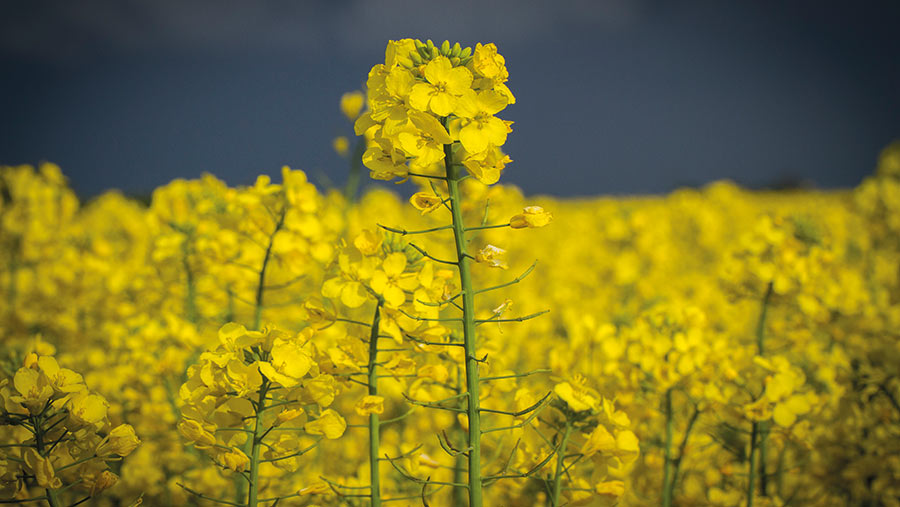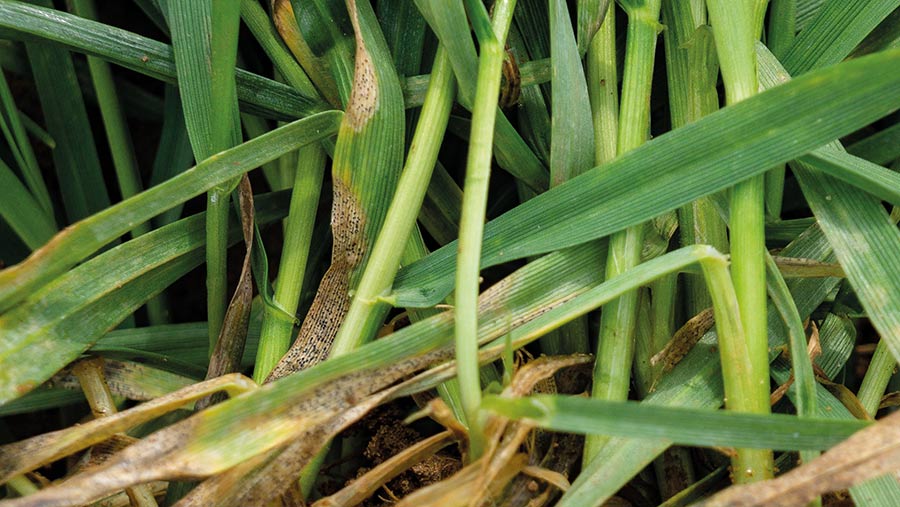Crop Watch: Blackgrass flowering in cold, wet spring
 © GNP
© GNP It’s proving to be a gloomy spring, and not just in terms of a lack of sunshine.
Growers have spring crops with headlands that have rotted off in the March rain, they are struggling to get inputs on at the right timing, and the rising septoria pressure in wheat is adding to already higher growing costs.
But if that isnt bad enough, one of our Crop Watch writers has discovered blackgrass that is flowering in the third week of April!
See also: Shallower potato cultivation depths recommended in wet season
North
David Martindale
Arable Alliance (Yorkshire)
The wet spring has continued to cause huge frustrations on various fronts. Spring drilling, potato planting, spraying and fertiliser applications have all been hampered, with jobs stacking up as weeks have often passed before they have been able to be completed.
On a positive note, the rain has certainly meant there are no drought issues this spring and nitrogen fertiliser has been washed in immediately. Overall, crops are looking well and appear to have good yield potential.
Winter wheat T1 fungicides are currently being applied. The main disease issue is extremely high levels of Septoria tritici, a disease which thrives during wet weather.
Infection levels are highest in susceptible varieties which were sown early.
Even the more resistant varieties are carrying concerning levels of Septoria tritici. Where necessary, T1 fungicide mixes have been increased to counter this high disease pressure.
Yellow rust this year is taking more of a back seat due to septoria being so dominant.
However, there are pockets of yellow rust appearing, especially where the T0 fungicide application was delayed.
T1 fungicide costs are going to be high due to a double whammy of higher fungicide application rates and significant price increases.
Winter barley and winter rye crops are racing through their growth stages, with flag leaves emerging. Brown rust has been prevalent in both crops, but some hybrid barley varieties in particular have high infection levels.
This has been made worse by severe delays in being able to apply the T1 fungicide.
Late-season plant growth regulators are being applied to reduce stem elongation in the upper part of the plant.
Flowering OSR
Oilseed rape crops are now flowering. Overall, most look well apart from those ravaged by pigeons, which have often spoiled what were once good crops.
In fields that were severely affected by cabbage stem flea beetle larvae, most have started to recover and are producing lots of flower buds.
The plants are stunted, though, and they have a lot of work to do to achieve a pleasing yield.
Attention is turning to sclerotinia control and the best fungicide timing based on weather conditions and risk of infection.
Seed weevil numbers have been low so far. However, they are just beginning to appear so will need controlling if the threshold is reached.
Winter beans have struggled during the wet spring so far. Where no pre-emergence herbicides were able to be applied it has meant a spring application of bentazone to try to control some key weeds.
Unfortunately, it has been too cold and wet for it to be applied so some crops are likely to be carrying high weed burdens.
In addition, chocolate spot lesions have peppered plants, as high levels of rainfall suit this disease. In some cases, downey mildew levels are also high as it fights with chocolate spot for leaf space.
Like winter wheat, the fungicide costs on winter beans are going to be significantly higher this year.
Spring beans sown in mid-February have established well and in general pea and bean weevil damage has been low.
Pre-emergence herbicides appear to be working well with very little weed emergence so far. No doubt herbicide efficacy has been maximised due to an ample supply of moisture.
The range of spring barley crops is vast, with some having only just been sown while earlier-drilled crops are soon going to start stem extension.
Weed emergence has been slow from the mid-February sown crops, but plenty are now present for a herbicide to be soon applied, which often can be mixed with the T1 fungicide.
East
Ben Pledger
Farmacy (Bedfordshire/Hertfordshire)
Catchy weather has been the theme of late. If it hasn’t been wind, it has been rain. The combination has been a driver for increased pressure from septoria tritici.
Rain splash has moved spores onto newer leaves, while the wind has driven spores up the plant by blowing upper leaves against infected lower ones.
This has seen the disease more prevalent than in recent years, and infection in some varieties with good disease scores is higher than one would have expected.
On the back of this, in most cases, T1 chemistry to protect leaf three has been based on mefentrifluconazole to hit the disease hard and take it out. Fenpicoxamid has also been used to achieve the same goal in several cases.
Where broad-leaved weeds are emerging in cereal crops, a herbicide is being added at T1 timing to take these out.
Where oilseed rape is being planned as the following crop, sulfonyl-urea based chemistry is being omitted where possible, to negate the risk of herbicide residue affecting the following crop.
Herbicide residue
In these situations, florasulam + halauxifen-methyl is being employed.
Slower emergence of broad-leaved weeds in some cases is seeing the need to hold off on a herbicide application, and potentially return at a later date if weed pressure increases.
Most spring crops are now in the ground. Earlier drilled spring barleys which were established in late February, have suffered on heavy land.
Heavy rains after drilling compacted and waterlogged turning headlands, to the extent that most of the seed rotted in wet soil.
Re-drilling or planting a cover crop in these areas, to establish a root system to benefit soil structure, would be a good plan.
Later drilled crops are slower to emerge and grow away due to recent cooler conditions. This is not helpful in sugar beet, where rapid growth to the 12-leaf stage is desired to reduce the risk of yield loss from virus yellows.
South
Tod Hunnisett
AICC (Sussex)
“The spring that keeps on giving” is how one of my more philosophical farmers ironically described this season.
Once again, I take my hat off to the operators who have snatched one-hour opportunities – probably at some unsociable hour over the Easter weekend – to cross a job off their elongating lists.
When there are a million things to do, all of which are a priority, it doesn’t matter what you do first, as long as something gets done.
I derive great pleasure in telling farmers that the best use of their time, in situations like this, is far more important than the minutiae of agronomy that their self-important consultant (ie me) might stipulate.
Blackgrass flowering on 20 April is a new one on me. Especially as two weeks earlier it was still flat on the floor.
Especially too, as it has had a ridiculously large amount of money spent on some super-duper new active that was promised to solve all our problems. I hope the local anaerobic digester plant can pasteurise its digestate.
Flag leaf
When this goes to press, there will be wheat in Kent with its flag leaf emerging. There will also be wheat on the Sussex Weald that is struggling to extend because it may just be responding to the fertiliser applied a month ago.
My growth regulator use on those crops will be minimal, if not non-existent. It’s amazing what you can get away without doing.
The countryside is gradually turning yellow, which is a good sign, because it means the OSR planted is still in good shape.
We’re learning how to deal with a different regime in terms of its establishment, but we must persevere because without doubt it is an extremely important break crop.
I’ve just had a farmer ring me. He’s looked at eight weather forecasts. If you average them out, there is a 50% chance of rain within the next half day.
Now I know, if there’s a 50% chance of something going wrong, nine times out of 10 it will do. So I’m tempted to reach for my glass half-full of gin and tonic…

Septoria tritici on wheat © Blackthorn Arable
West
Neil Potts
Matford Arable (Devon)
It has been a long time since we last had such a cold, wet spring, and the effect of the weather has been quite profound.
Spring drillings of cereals, maize and beet have all been delayed as we wait for the soil to warm and dry out to an extent where a seed-bed can be produced.
It is for seasons like this that the old expression “Better to be out of season than out of reason” was used to warn about mucking crops into the ground.
Timings of many fertiliser and agchem products have been compromised by the weather, as ground conditions have been too wet to travel and spray days at a premium.
It is always the case that the very weather that is putting a delay into fungicide applications, is the same weather that is causing the disease situation to worsen.
Most wheat crops are carrying worryingly high levels of septoria and with fungicides providing far less “kick-back” than they used to, delayed T1s will inevitably lead to poorer disease control than we would hope for.
Some of the more forward wheat crops have been at growth stage 33 before they received their T1.
Cold, wet soil conditions have lead to slow responses to nitrogen applications when they have gone on, with wet areas in fields looking much paler than the more free draining ones. In all, the situation at present is looking very average, but as we all know this can change dramatically with a few dry, warm days.
We just have to hope that they appear pretty quickly now.
Phoma
Winter OSR crops are looking quite promising, with most crops now in full flower. There is, however, evidence of phoma in the few crops that did not receive an autumn fungicide for one reason or another.
The dilemma now is, will a treatment be effective or will the disease have made it from leaf to stem to become full blown stem canker. Only time will tell.
Spring cereals that were planted in the dry February are looking reasonably well and are currently at the mid-tillering stage.
They should have received all their nitrogen by now and be set fair, but again will, like the winter crops, want to see some drier and warmer weather.
With a lot of spring planting left to happen, I would just like to take the opportunity to wish everyone good luck and to remind people that often the most important day in the life of a crop is the day it goes in the ground.
The better the planting conditions, the better the crop, so please exercise patience as well.

